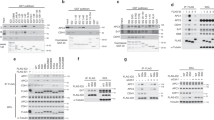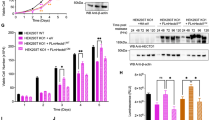Abstract
The anaphase-promoting complex/cyclosome (APC/C) is an ubiquitin ligase that functions during mitosis. Here we identify the transcriptional regulator, transcriptional intermediary factor 1γ, TIF1γ, as an APC/C-interacting protein that regulates APC/C function. TIF1γ is not a substrate for APC/C-dependent ubiquitylation but instead, associates specifically with the APC/C holoenzyme and Cdc20 to affect APC/C activity and progression through mitosis. RNA interference studies indicate that TIF1γ knockdown results in a specific reduction in APC/C ubiquitin ligase activity, the stabilization of APC/C substrates, and an increase in the time taken for cells to progress through mitosis from nuclear envelope breakdown to anaphase. TIF1γ knockdown cells are also characterized by the inappropriate presence of cyclin A at metaphase, and an increase in the number of cells that fail to undergo metaphase-to-anaphase transition. Expression of a small interfering RNA-resistant TIF1γ species relieves the mitotic phenotype imposed by TIF1γ knockdown and allows for mitotic progression. Binding studies indicate that TIF1γ is also a component of the APC/C-mitotic checkpoint complex (MCC), but is not required for MCC dissociation from the APC/C once the spindle assembly checkpoint (SAC) is satisfied. TIF1γ inactivation also results in chromosome misalignment at metaphase and SAC activation; inactivation of the SAC relieves the mitotic block imposed by TIF1γ knockdown. Together these data define novel functions for TIF1γ during mitosis and suggest that a reduction in APC/C ubiquitin ligase activity promotes SAC activation.
This is a preview of subscription content, access via your institution
Access options
Subscribe to this journal
Receive 50 print issues and online access
$259.00 per year
only $5.18 per issue
Buy this article
- Purchase on Springer Link
- Instant access to full article PDF
Prices may be subject to local taxes which are calculated during checkout







Similar content being viewed by others
References
Peters JM . The anaphase promoting complex/cyclosome: a machine designed to destroy. Nat Rev Mol Cell Biol 2006; 7: 644–656.
Musacchio A, Salmon ED . The spindle-assembly checkpoint in space and time. Nat Rev Mol Cell Biol 2007; 8: 379–393.
Yu H . Cdc20: A WD40 activator for a cell cycle degradation machine. Mol Cell 2007; 27: 3–16.
Turnell AS, Stewart GS, Grand RJ, Rookes SM, Martin A, Yamano H et al. The APC/C and CBP/p300 cooperate to regulate transcription and cell-cycle progression. Nature 2005; 438: 690–695.
Turnell AS, Mymryk JS . Roles for the coactivators CBP and p300 and the APC/C E3 ubiquitin ligase in E1A-dependent cell transformation. Br J Cancer 2006; 95: 555–560.
Townsend K, Mason H, Blackford AN, Miller ES, Chapman JR, Sedgwick GG et al. Mediator of DNA damage checkpoint 1 regulates mitotic progression. J Biol Chem 2009; 284: 33939–33948.
Venturini L, You J, Stadler M, Galien R, Lallemand V, Koken MH et al. TIF1gamma, a novel member of the transcriptional intermediary factor 1 family. Oncogene 1999; 18: 1209–1217.
Peng H, Feldman I, Rauscher FJ . Hetero-oligomerization among the TIF family of RBCC/TRIM domain-containing nuclear cofactors: a potential mechanism for regulating the switch between coactivation and corepression. J Mol Biol 2002; 320: 629–644.
Klugbauer S, Rabes HM . The transcription coactivator HTIF1 and a related protein are fused to the RET receptor tyrosine kinase in childhood papillary thyroid carcinomas. Oncogene 1999; 18: 4388–4393.
Ransom DG, Bahary N, Niss K, Traver D, Burns C, Trede NS et al. The zebrafish moonshine gene encodes transcriptional intermediary factor 1 gamma, an essential regulator of hematopoiesis. PLoS Biol 2004; 2: 1188–1196.
He W, Dorn DC, Erdjument-Bromage H, Tempst P, Moore MA, Massague J . Hematopoiesis controlled by distinct TIF1gamma and Smad4 branches of the TGFbeta pathway. Cell 2006; 125: 929–941.
Dupont S, Zacchigna L, Cordenonsi M, Soligo S, Adorno M, Rugge M et al. Germ-layer specification and control of cell growth by ectodermin, a Smad4 ubiquitin ligase. Cell 2005; 121: 87–99.
Dupont S, Mamidi A, Cordenonsi M, Montagner M, Zacchigna L, Adorno M et al. FAM/USP9x, a deubiquitinating enzyme essential for TGFbeta signaling, controls Smad4 monoubiquitination. Cell 2009; 136: 123–135.
Shimwell NJ, Martin A, Bruton RK, Blackford AN, Gallimore PH, Turnell AS et al. Adenovirus 5 early region 1A associates with insulin receptor substrates. Oncogene 2009; 28: 686–697.
Reimann JD, Freed E, Hsu JY, Kramer ER, Peters JM, Jackson PK . Emi1 is a mitotic regulator that interacts with Cdc20 and inhibits the anaphase promoting complex. Cell 2001; 105: 645–655.
Miller JJ, Summers MK, Hansen DV, Nachury MV, Lehman NL, Loktev A et al. Emi1 stably binds and inhibits the anaphase-promoting complex/cyclosome as a pseudosubstrate inhibitor. Genes Dev 2006; 20: 2410–2420.
Mansfeld J, Collin P, Collins MO, Choudhary JS, Pines J . APC15 drives the turnover of MCC-CDC20 to make the spindle assembly checkpoint responsive to kinetochore attachment. Nat Cell Biol 2011; 13: 1234–1243.
Hunt T, Luca FC, Ruderman JV . The requirements for protein synthesis and degradation, and the control of destruction of cyclins A and B in the meiotic and mitotic cell cycles of the clam embryo. J Cell Biol 1992; 116: 707–724.
Di Fiore B, Pines J . How cyclin A destruction escapes the spindle assembly checkpoint. J Cell Biol 2010; 190: 501–509.
Matyskiela ME, Morgan DO . Analysis of activator-binding sites on the APC/C supports a cooperative substrate-binding mechanism. Mol Cell 2009; 34: 68–80.
Izawa D, Pines J . How APC/C-Cdc20 changes its substrate specificity in mitosis. Nat Cell Biol 2011; 13: 223–233.
den Elzen N, Pines J . Cyclin A is destroyed in prometaphase and can delay chromosome alignment and anaphase. J Cell Biol 2001; 153: 121–136.
Hayes MJ, Kimata Y, Wattam SL, Lindon C, Mao G, Yamano H et al. Early mitotic degradation of Nek2A depends on Cdc20-independent interaction with the APC/C. Nat Cell Biol 2006; 8: 607–614.
Wolthuis R, Clay-Farrace L, van Zon W, Yekezare M, Koop L, Ogink J et al. Cdc20 and Cks direct the spindle checkpoint-independent destruction of cyclin A. Mol Cell 2008; 30: 290–302.
Zeng X, Sigoillot F, Gaur S, Choi S, Pfaff KL, Oh DC et al. Pharmacologic inhibition of the anaphase-promoting complex induces a spindle checkpoint-dependent mitotic arrest in the absence of spindle damage. Cancer Cell 2010; 18: 382–395.
Reddy SK, Rape M, Margansky WA, Kirschner MW . Ubiquitination by the anaphase promoting complex drives spindle checkpoint inactivation. Nature 2007; 446: 921–925.
Stegmeier F, Rape M, Draviam VM, Nalepa G, Sowa ME, Ang XL et al. Anaphase initiation is regulated by antagonistic ubiquitination and deubiquitination activities. Nature 2007; 446: 876–881.
Ge S, Skaar JR, Pagano M . APC/C- and Mad2-mediated degradation of Cdc20 during spindle checkpoint activation. Cell Cycle 2009; 8: 167–171.
Nilsson J, Yekezare M, Minshull J, Pines J . The APC/C maintains the spindle assembly checkpoint by targeting Cdc20 for destruction. Nat Cell Biol 2008; 10: 1411–1420.
Chung E, Chen RH . Phosphorylation of Cdc20 is required for its inhibition by the spindle checkpoint. Nat Cell Biol 2003; 5: 748–753.
D'Angiolella V, Mari C, Nocera D, Rametti L, Grieco D . The spindle checkpoint requires cyclin-dependent kinase activity. Genes Dev 2003; 17: 2520–2525.
Qi W, Yu H . KEN box-dependent degradation of the Bub1 spindle checkpoint kinase by the anaphase-promoting complex/cyclosome. J Biol Chem 2007; 282: 3672–3679.
Choi E, Choe H, Min J, Choi JY, Kim J, Lee H . BubR1 acetylation at prometaphase is required for modulating APC/C activity and timing of mitosis. EMBO J 2009; 28: 2077–2089.
Ricke RM, Jeganathan KB, van Deursen JM . Bub1 overexpression induces aneuploidy and tumor formation through Aurora B kinase hyperactivation. J Cell Biol 2011; 193: 1049–1064.
Wan Y, Liu X, Kirschner MW . The anaphase-promoting complex mediates TGF-β signaling by targeting SnoN for destruction. Mol Cell 2001; 8: 1027–1039.
Zhang L, Fujita T, Wu G, Xiao X, Wan Y . Phosphorylation of APC/Cdc27 is involved in TGF-β signaling. J Biol Chem 2011; 286: 10041–10050.
Yang Y, Kim AH, Yamada T, Wu B, Bilimoria PM, Ikeuchi Y et al. A Cdc20-APC ubiquitin signaling pathway regulates presynaptic differentiation. Science 2009; 326: 575–578.
Massagué J, Gomis RR . The logic of TGFβ signaling. Febbs Lett 2006; 580: 2811–2820.
Chaudhry MA, Chodosh LA, McKenna WG, Muschel RJ . Gene expression profiling of HeLa cells in G1 or G2 phases. Oncogene 2002; 21: 1934–1942.
Xu YX, Manley JL . New insights into mitotic chromosome condensation: a role for the prolyl isomerase Pin1. Cell Cycle 2007; 23: 2896–2901.
Blackford AN, Patel RN, Forrester NA, Theil K, Groitl P, Stewart GS et al. Adenovirus 12 E4orf6 inhibits ATR activation by promoting TOPBP1 degradation. Proc Natl Acad Sci USA 2010; 107: 12251–12256.
Rasti M, Grand RJA, Yousef YF, Shuen M, Mymryk JS, Gallimore PH et al. Roles for APIS and the 20S proteasome in adenovirus E1A-dependent transcription. EMBO J 2006; 25: 2710–2722.
Acknowledgements
We thank Francis Barr, Andrew Fry, Stefano Piccolo, Frank Rauscher III, Hughes de Thé and Hiroyuki Yamano for reagents. This work was funded by CR-UK (C10000/A7542) and The University of Birmingham, College of Medical and Dental Sciences Research Development Fund. JN is supported by The Danish Cancer Society and the Lundbeck Foundation.
Author contributions: GGS and AST initiated the study; GGS, JN and AST designed the study; GGS, KT, AM, NJS, JN and AST performed experiments and analyzed data. RJAG and GSS helped supervise the study. AST wrote the paper.
Author information
Authors and Affiliations
Corresponding author
Ethics declarations
Competing interests
The authors declare no conflict of interest.
Rights and permissions
About this article
Cite this article
Sedgwick, G., Townsend, K., Martin, A. et al. Transcriptional intermediary factor 1γ binds to the anaphase-promoting complex/cyclosome and promotes mitosis. Oncogene 32, 4622–4633 (2013). https://doi.org/10.1038/onc.2012.501
Received:
Revised:
Accepted:
Published:
Issue Date:
DOI: https://doi.org/10.1038/onc.2012.501
Keywords
This article is cited by
-
Cellular TRIM33 restrains HIV-1 infection by targeting viral integrase for proteasomal degradation
Nature Communications (2019)
-
Tumour suppressor TRIM33 targets nuclear β-catenin degradation
Nature Communications (2015)



